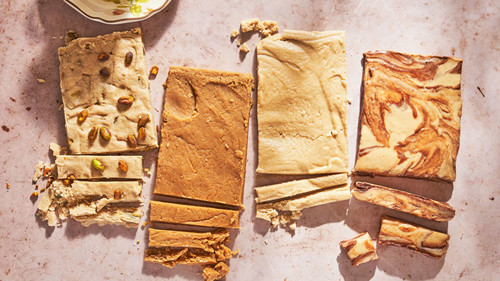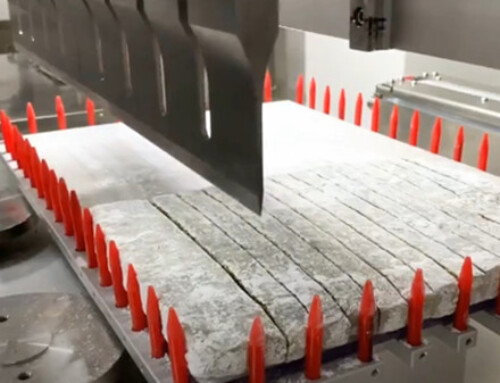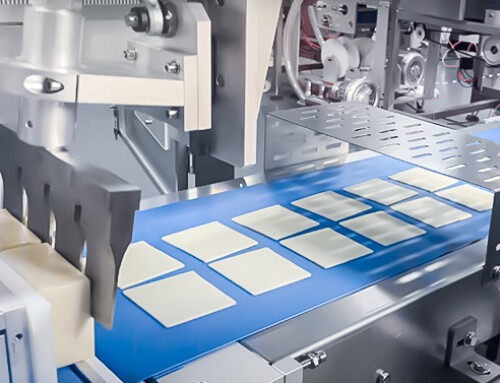Project Description
Cutting Halva
Cutting Halva – The Best Square Cake Cutter – Cheersonic
Halva—— Have you ever tried such flaky candy?
Halva refers to various local confection recipes in West Asia and its vicinity.The name is used for referring to a huge variety of confections, with the most geographically common variety based on fried semolina.
Many of the earlier Persian recipes were documented in the 13th century Arabic book Kitab al-Tabikh (The Book of Dishes), as well as an anonymous cookbook from 13th-century Moorish Spain. Halva was adopted and expanded by the Ottoman Turks, including a sesame-based version, and spread throughout their empire.
Most types of halva are relatively dense confections sweetened with sugar or honey. Their textures, however, vary. For example, semolina-based halva is gelatinous and translucent, while sesame-based halva is drier and more crumbly.
Semolina halva is usually made with wheat semolina, sugar or honey, and butter or vegetable oil. Raisins, dates, other dried fruits, or nuts such as almonds or walnuts are often added to semolina halva. The halva is very sweet, with a gelatinous texture similar to polenta; the added butter gives it a rich mouthfeel. This kind of halva is mostly popular in India and Pakistan.
Sesame halva is popular in the Balkans, Poland, Middle East, and other areas surrounding the Mediterranean Sea. The primary ingredients in this confection are sesame butter or paste (tahini), and sugar, glucose or honey. Soapwort (called ‘erq al halaweh in Arabic; çöven in Turkish), egg white, or marshmallow root are added in some recipes to stabilize the oils in the mixture or create a distinctive texture for the resulting confection. A version of sesame halva, called sesame crumble candy (芝麻酥糖) in China uses ground sesame and sugar, cooked to the hard ball stage because it is made crispier than other halvas. Other ingredients and flavorings, such as pistachio nuts, cocoa powder, orange juice, vanilla, or chocolate are often added to the basic tahini and sugar base
Sesame Halva Recipe
INGREDIENTS
1 1/2 cups well-stirred tahini, room temperature
1/4 tsp. kosher salt
1/2 tsp. vanilla extract
1 1/4 cups sugar
PREPARATION
1.Line an 8×8″ baking pan or a 9×4″ loaf pan with parchment paper, leaving a 2″ overhang on 2 sides. Using a wooden spoon, mix tahini, salt, and vanilla in a medium heatproof bowl.
2.Pour 1/4 cup water into a small saucepan, then stir in sugar. Attach a candy thermometer to side of pan.
3.Bring sugar to a boil over medium-high heat and cook, stirring occasionally to help sugar dissolve, until thermometer registers 250°F. Immediately remove syrup from heat. Gradually stream syrup into tahini mixture, mixing tahini constantly with wooden spoon.
4.Continue to stir just until halva comes together in a smooth mass and starts to pull away from sides of bowl (less than a minute). Be careful not to overmix or halva will be crumbly.
5.Working quickly, scrape halva into prepared pan, pushing toward edges; smooth top.
6.Let cool to room temperature, then cover tightly with plastic and chill at least 2 hours.
7.Remove from pan using parchment overhang. Slice as desired to serve.
Actually, Halva can be made 3 weeks ahead. Transfer to an airtight container and chill. Or to cut it into small piece before transportation. It can be sliced when frozen or after cooling down.
Sometimes, halva is sticky, and sometimes it is crispy. For normal cutter, it is not easy to hold on. Ultrasonic cutter with high frequency of vibration could help slice halva more beautifully and smoothly without making the halva crushed.
Cheersonic makes automated cutting solutions for most kinds of baked food according to customers’ demand. Ultrasonic cutting technology is advanced. We quickly adjust the size of the machine blades, and quickly cut the products into slices with the specified size and shapes you want it to be. The most important benefit is ultrasonic High-quality aesthetics brought by cutting.
Try halva ! Try ultrasonic!





